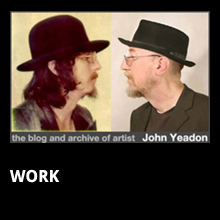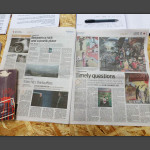Timely Questions….
Timely Questions in the Morning Star 26th May, by Julie Chamberlain
[Originally called “Dramatic exhibition asks how much things have really moved on since the 80s”, published in www.privateviewii.com]
[article as it appeared in the Morning Star – click for full-size view]
–
Oh the irony. An exhibition of paintings criticised 34 years ago in a newspaper editorial as “smut not art” is now on show in the building where that editorial was written and printed.
What’s The Meaning of This? is the title of the ‘selective retrospective’ by John Yeadon, a show to mark reaching 70 and also look back at what may or may not have changed over the years. Is society more tolerant and open minded, is Coventry more enlightened and less provincial, he asks?
The front page story of 1984 in which a Tory councillor raged against an exhibition of Yeadon’s paintings as “overtly pornographic” is put on show on the wall, alongside the editorial. The exhibition was called Dirty Tricks and was on at what Yeadon calls the high point of Aids paranoia and ‘gay blame’; he describes the works as allegorical Grotesque Realist paintings.
John says the exhibition of his works at The Herbert increased attendance 40 per cent afterwards. Some of the paintings from that exhibition are on show here in what was the paper’s last news room on its Corporation Street site, before it moved to smaller premises reflecting the decline of print journalism.
It’s a trip down memory lane for me after nearly 19 years spent working at the Cov Tel, though the newsroom moved within the Corporation Street building during those years so the critical editorial wouldn’t have been written in the same room where the paintings are now displayed.
However the room is perfectly proportioned for them, the largest ones fitting brilliantly almost floor to what was the ceiling; the low, oppressive false ceiling fellow journalists will remember has been removed to show the industrial spaces above and the blinds – always closed to stop glare on the computers – are now open.
The Beach Party (before the rain) and The Deluge (after the rain) from 1981 and 82 start the show, the first depicting men on a beach, frolicking and partying but in a strange contorted way, playing on a seesaw and dancing around, lots of them semi-naked. The Deluge is darker, literally and metaphorically, with one man being carried by others, their heads covered in bags; the fun is over.
Another painting from 1981, the year of the Charles and Diana royal wedding, the march for jobs and hunger strikes, is called The British Scene/summer 1981, and ironic British flags pop up all over the strange groups of people.
Democratic Circus from 1982 features two panels, State Apartments and Assembly Rooms, the official titles at odds with the depictions of men having sex, maybe showing what’s really going on behind the official scenes.
Suicide Street is another dark work, a man created from black intense swirls to show his outline and torso, with Zombie on Suicide Street written on it.
Boy Venus (Sunday Draws In) of 1987 shows a good looking naked young man starting straight at the artist, as another man enters the room through the curtains. Midnight of Freedom shows a naked black man crouched on a television, looking wary.
There’s also a whole corner of large paintings of naked men in various scenes.
John’s series of paintings of his family and his ventriloquist dummies aren’t included in this selective exhibition, nor his digital pieces concentrating on food and obesity (which also gathered negative press attention), but there are a number from his Englandia series, showing pleasant small paintings; a duck house to again reflect a political scandal of a few years ago, plus pastoral fields of English countryside, and other fields with human invasions of pylons and powerlines, railway tracks and windfarms.
Even more recent paintings – a Control Room at Sellafield, showing one man in charge of a bank of screens and buttons, and It’s Alive!, his 2017 version of a much older paintings of the WITCH computer at Bletchley – also feature.
I wouldn’t even think of trying to answer John’s questions about society and Coventry in particular and how it’s changed over the years. But after what will probably be more than half my working lifetime spent at the Coventry Evening Telegraph building it was interesting to visit for the last time before it’s conversion to a hotel and see in particular some works from an exhibition I wasn’t in Coventry for the first time around, and hope that such an editorial would never be written today.
Julie Chamberlain, June 2018

